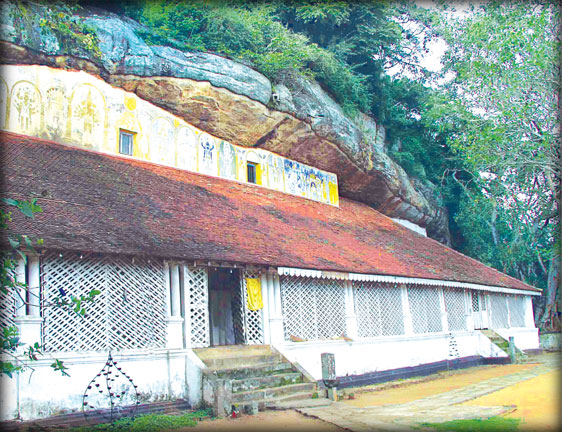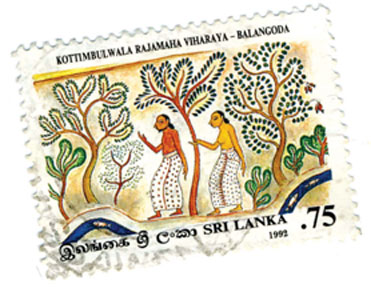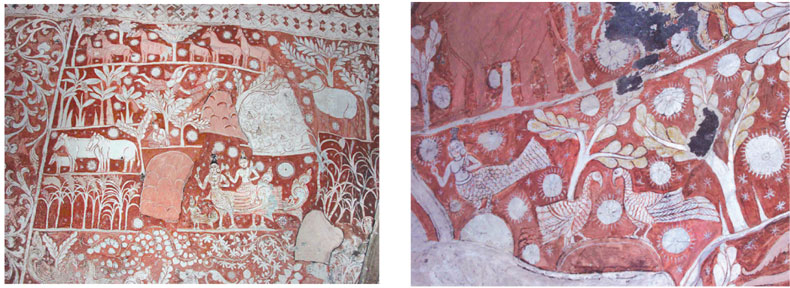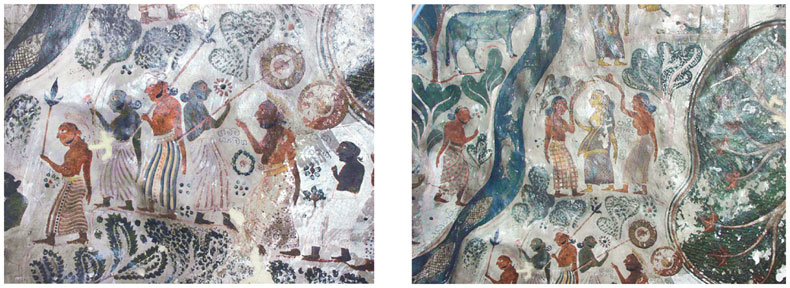Kottimbulwala cave temple - Buddha's life story in murals
Story and pictures by Mahil Wijesinghe
|

The view of the drip-ledged rock cave temple of
Kottimbulwala |
Driving past the picturesque countryside along undulating narrow
country roads in Balangoda one can see numerous historic temples, but
there are several lesser known temples which are unique in their own
way. Recently I went in search of the Kottimbulwala cave temple, which
is considered to be one of the foremost cave temples with unique ancient
paintings.
After travelling about 15 kilometres on Pallebedda - Balangoda road
taking the turn to the right at Weligepola town and proceeding a further
seven kilometres on the desolate Kottimbulwala road, we reached the
Kottimbulwala cave temple complex. A gravel road turned inwards leading
to the modern temple (Avasa Ge) and the Kottimbulwala cave temple.
 We
stopped our vehicle at the bottom of a rocky outcrop and we first went
into the modern temple (Avasa Ge). The ancient cave shrine was situated
high on the face of the rock. A steep flight of steps through the trees
leads towards the cave shrine and an overhanging rock has been converted
into the cave temple. We
stopped our vehicle at the bottom of a rocky outcrop and we first went
into the modern temple (Avasa Ge). The ancient cave shrine was situated
high on the face of the rock. A steep flight of steps through the trees
leads towards the cave shrine and an overhanging rock has been converted
into the cave temple.
Below the drip-ledged cave some interesting modern paintings can be
seen on the outer side of the plastered wall between the brow of the
rock and the tiled roof. This tiled roof and beautiful work of lactic
wall give a more airy appearance to the cave shrine. The main cave has
been divided into three compartments housing three shrine rooms in
different periods of time.
History
 The
Kottimbulwala cave temple, with a history dating back to the days of
King Valagamba in the 9th century BC, is considered to be one of the
foremost cave temples with ancient murals. The temple had been renovated
by several later Kings right up to the reign of the Kandyan Kings in the
c18th and 19th centuries. The
Kottimbulwala cave temple, with a history dating back to the days of
King Valagamba in the 9th century BC, is considered to be one of the
foremost cave temples with ancient murals. The temple had been renovated
by several later Kings right up to the reign of the Kandyan Kings in the
c18th and 19th centuries.
The rock cave temple contains unique and rare Kandyan period murals
on the rock. The main rock cave is 120 ft in length and has a width of
25 ft. There are three caves in the same rock with murals in different
styles and colours.
One of the main attractions in the Kottimbulwala cave temple is the
image-house inside a drip-ledged cave with classical paintings. The
smallest cave in the same rock at the extreme corner was the oldest part
of the cave with its ceiling covered with ancient paintings belonging to
9th century BC of Anuradhapura period. It contains murals fairly
different from those of the main cave.
The Sama Jathaka story is illustrated on the whole ceiling and the
walls. The paintings in this cave are believed to be the oldest. They
comprise several colours and different styles with more white in
background. These paintings are similar to the paintings in the temples
in the Southern coastal belt. Although the paintings in the temples in
the coastal belt have been drawn in panels, the paintings in the
Kottimbulwala are not in panels. They are entirely different from
Kandyan style. The ceiling of the cave is also adorned with beautiful
lotus petals in full bloom.
Kandyan
In the same cave a seated Buddha images with an enchanting Makara
Thorana was built in a miniature shrine room. Most of the paintings here
are very simple and the background is kept blank in white. There is a
Buddha statue which was carved of wood which has now decayed and placed
in the corner of this shrine.
The middle compartment contains a huge recumbent Buddha statue and
the ceiling and the walls too are covered with paintings belonging to
the Kandyan period. We were told that the paintings in this shrine were
more advanced when compared with the paintings in the old shrine.
Looking at the paintings in this shrine we realised that the artists
have used mostly two colours - red and white to illustrate the stories.
The third part of the cave also houses several Buddha statues and
paintings which belong to modern times. Most of the paintings were done
on the wooden ceiling illustrating Jathaka stories and the walls
depicted deities. The paintings have been done using an array of vibrant
colours.
The stamps issued by the Postal Department in Vesak season over the
years carried the paintings from temples in numerous parts of the
country. The stamps help to create awareness on temples which had
beautiful works of art by ancient painters. Considering the antiquity of
paintings, in 1992 some of the paintings found on the ceiling of the old
shrine of Kottimbulwala cave temple were used to illustrate the postage
stamps.
|

The paintings belonging to Kandyan period in the ceiling of
middle shrine |
|

The oldest paintings of the temple which illustrate the Sama
Jathakaya |
|

